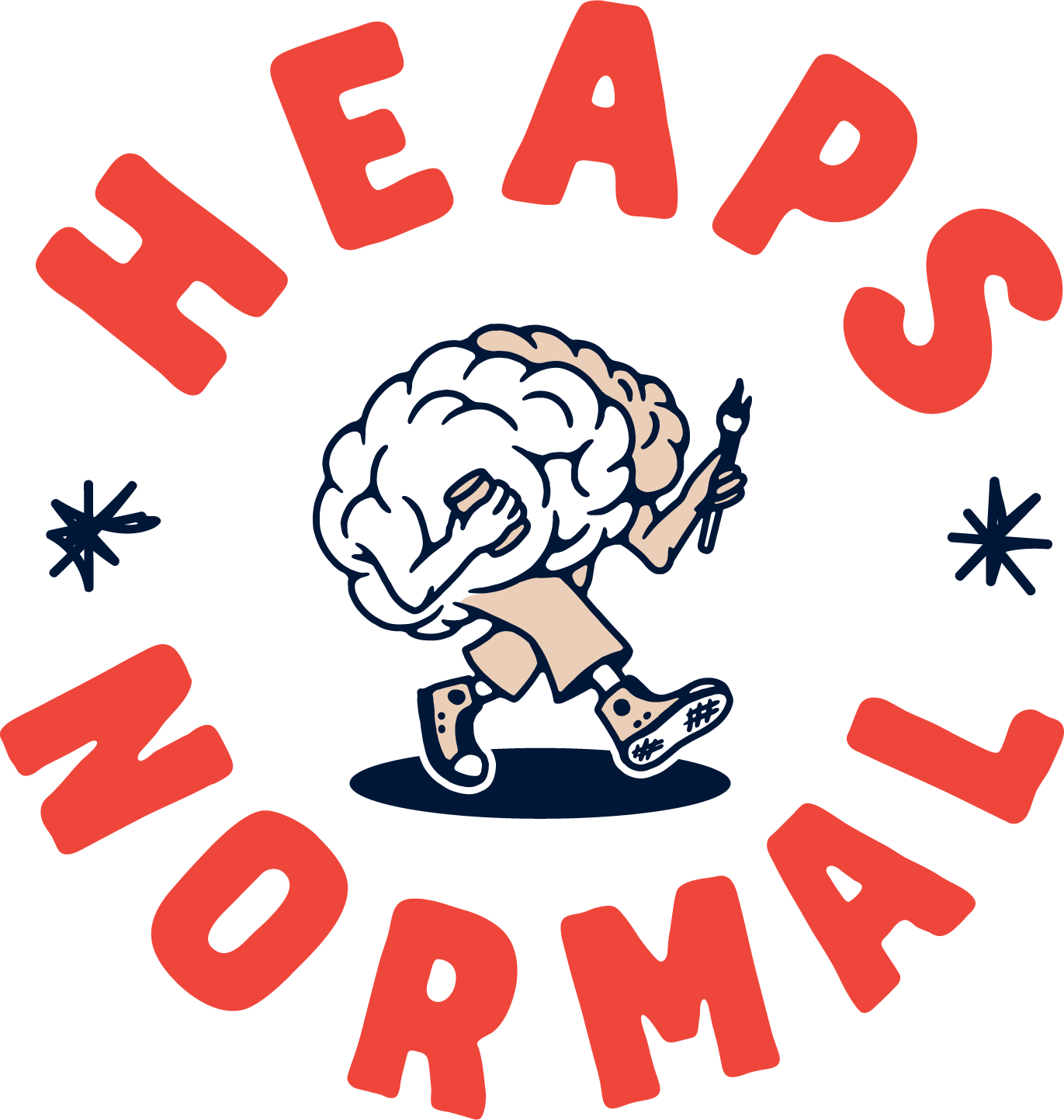LARA OLUKLU
This is Not Everything that I Know
2024
❦
Jincheng Deng w/ Huang Xuebin, Flying Backwords
Gallery Two, 13 Jul 2024—11 Aug 2024

Imagine that there is nothing which you cannot observe. It may provide you with great pleasure and, in doing so, great concentration and even anxious questioning about the very nature of objects and things, seeing as you (of course) can observe
For Graham Harman, everything is an object (including you and your thoughts,) and no single object relates to any other object. The linkage between an object and every other object is broken. This is because objects withdraw into themselves, becoming self-subsisting, autonomous entities. Essentially, Harman is stating that objects “exceed” every relation from which they might enter. Therefore, according to Harman, all objects are equal and ontologically on the same plane. Here, we can gather that Harman is attempting to de-centre the human (or subject) when thinking about the metaphysical ontology of objects, their ‘being’ in the world. In this removal, Harman argues for a disavowal of dualism, the notion that mental phenomena and physical phenomena are distinct and separable from one another.
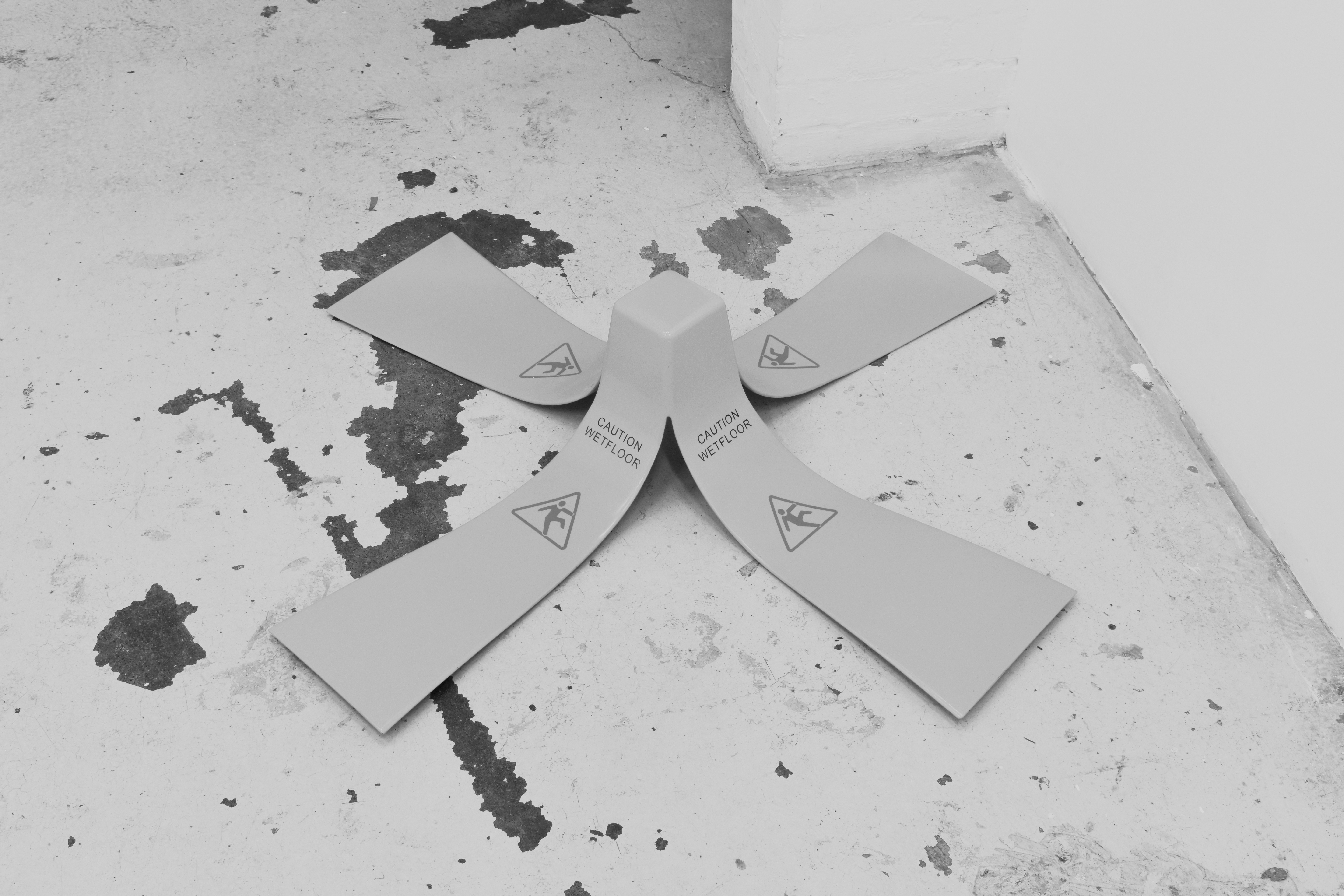
Although objects lie everywhere around us in our external world, Jincheng Deng and Huang Xuebin remove them from their daily use, function and objective value. Perhaps comedically, our preconceived notions of an object and its symbolic value–its functionality and aesthetic essence– are flipped and broken, as segregated roads dotted with checkpoints struggle to reach a secluded seaside town. Instead, Deng presents us with objects beyond ‘real’ worldly use. A caution wet floor sign is detached from its object-oriented purpose, and we stare at an impersonation of a banana peel. Similar to those used in Mario Kart, to prevent your fellow opponents from catching up to you. To force you to slip rather than avoid harm. A safety construction hat is transformed through repetition and sized up into a bumble bee, possibly signalling a notion of busy workers (–like hardworking busy bees.) A vacuum cleaner becomes a fuel gun. Or does the fuel gun become the vacuum cleaner? Sometimes, you cannot tell where one object starts and another one finishes. A road you travel frequently, or the roots of your family tree, might be more luminous, more knowable. The objects are tightly squeezing themselves into the uncanny. Nearly. It is too early to say. Now, you are observing something you thought you may never observe.
Walking through the second space in the TCB gallery, an accumulation of these unknown objects besiege you. The materiality is bitter and bleak, and there is almost little sign of dexterity in the work. Alone, you may wonder what technology was used to produce these awkward objects. The worker’s helmets gleam back at me under the fluorescent lighting, cold and shiny. The breeze taps against the entrance outside the gallery walls and I wonder if it’d be enough to blow the objects out and over, dissolving further into nothing. The plasticity of the objects feels toxic. The helmets have been repeated and reproduced, over and over, their initial sign begins to fail despite their considerable size. The object seems to be encasing itself, rigidly solid. It stands over its original form and context, the meaning now becoming obscured. The essence is lost. I wonder if they are able to escape and conjure a strange and unfamiliar replacement.
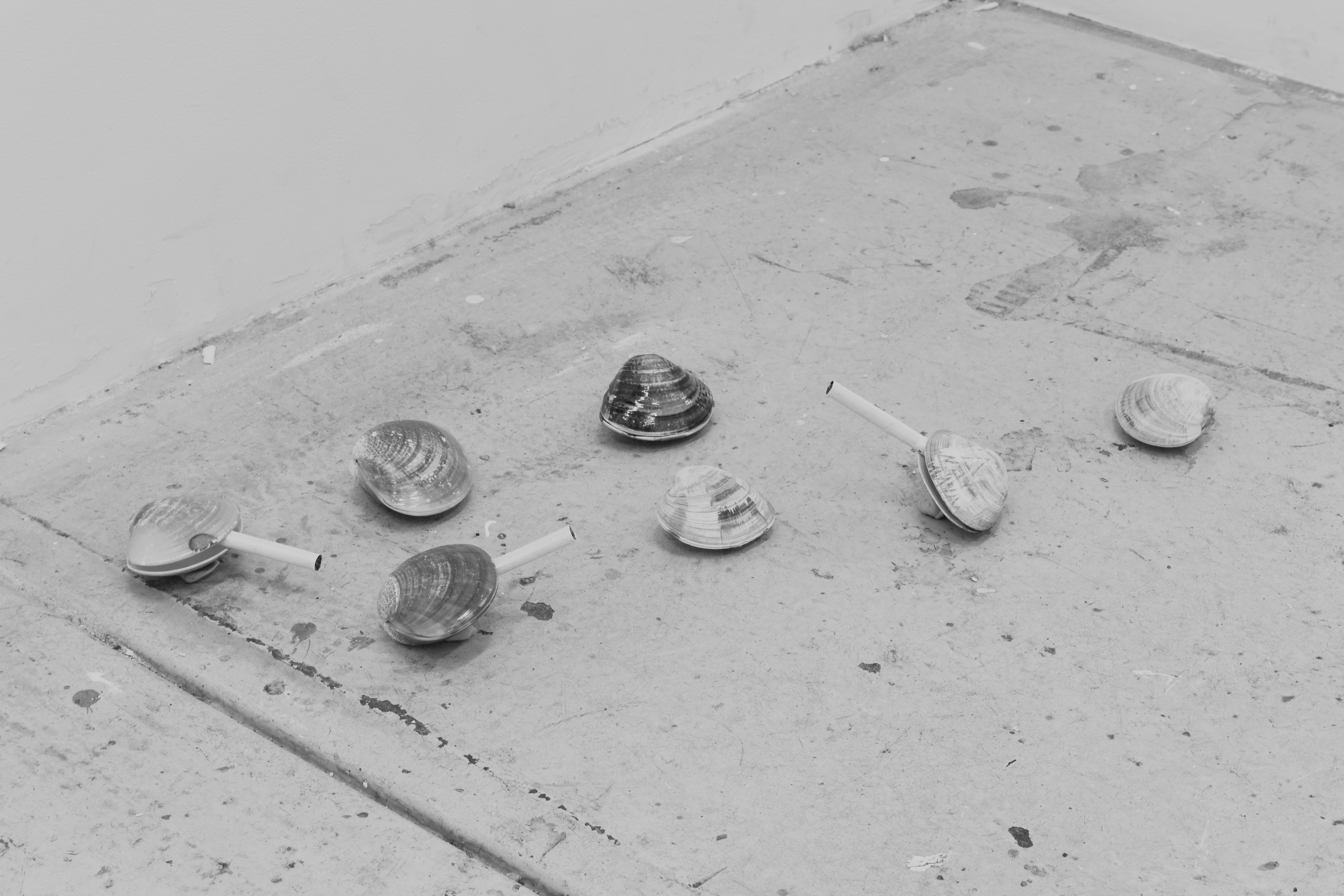
This work will be alive longer than you or I. Maybe that’s the point. The constructed space of labour-related objects seeks to represent a “universal experience” (whose universal experience?) of the everyday mundanity of contemporary life. The blank objects pursue a seamless, frictionless reality that, defeatedly, does nothing to erase its destructive and dysfunctional presence in the existing world. As I walk beneath the giant hanging eye drops, I notice the textures on the surface, which differ significantly from the other works in the space. The outer layer is blurred. The clouded surface evokes something less than a commodified object, yet its meaning still hovers in ambiguity. Twirling slowly, it severs itself–just as all of Deng’s sculptures in the gallery– from an introduction to social, political and historical context. What must we do with and how must we treat the objects and things we cannot use? The mussels strewn on the corner floor seek refuge (from what or whom is unknown) in the collective experience of a hearty cigarette.
⊱✿⊰
Suppose we follow Harman’s thought that the universe is devoid of relation (a wild argument…). That being so, these amalgamations of two opposing objects can still maintain their singular states of ‘being’ in the world. However, when we look at the work in Flying Backwards, we (may) observe that the individual power of each object has dimmed. The object(s) can no longer be used for their intended purpose. At the hands of Deng’s sculptural world, we are revealed that an autonomous subject (ironically) lies at the heart of each object. As Harman’s object-oriented ontology sought to weaken dualism’s binary grasp on our day-to-day world (from our external social environment to the structures of power that uphold oppressive hierarchies of race, class, gender and sexuality,) we can acknowledge then, (through Deng’s object sculptures,) that this
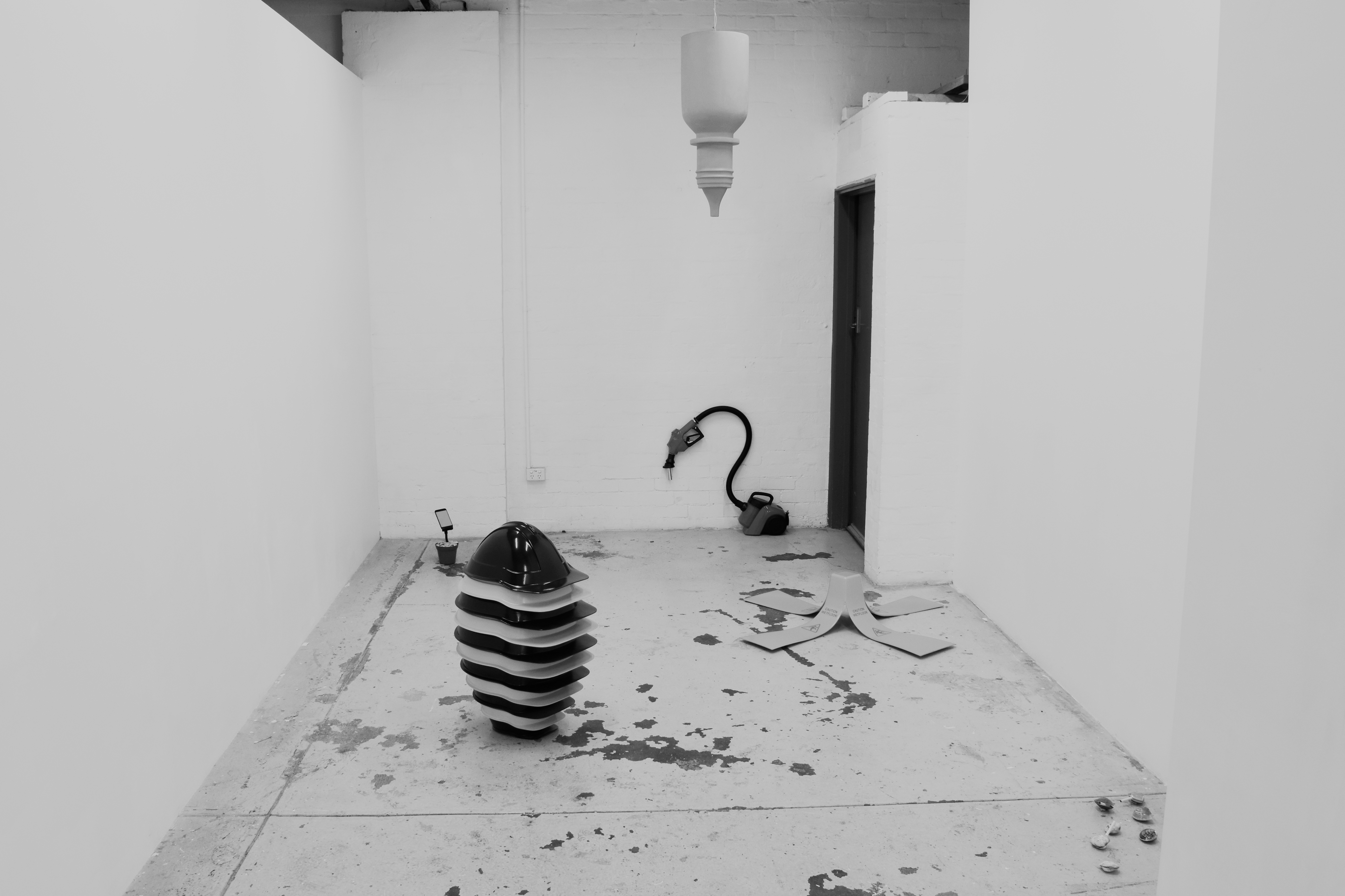
Deng’s work reminds me of the apparent relation between objects and translates to me that chaos can be both order and disorder. In arguing for opacity, Glissant wrote, “The poetic force of the object is radiant.” Expressing how a relation of different–separate–opposing parts is always relevant in constructing a whole (object or self.) In the tireless quest for truth and certainty, where identity politics dominates our external world, it may be earnest and even generous to recall that all objects are like a woven fabric, intricately linking distinct selves that are not wholly one or the other. A few days ago, a dear friend of mine taught me the word palimpsest. It refers to something reused or altered but still, bears visible traces of its earlier original form–a filling of a wound. Rather than severing a relation between objects entirely, we can feel that looking on, in(wards) and under the scarred skin of the object, other possible ways of ‘being’ emerge that resist tirelessly against oppressive binaries of power.
⊱✿⊰
suture –– noun 1. stitching of the edges of a wound or incision. 2. thread or wire used for this.
verb suture(ing) stitch (a wound or incision).
Eighth Edition Oxford English Dictionary
Today, nothing is the atom of my Northern star
a closure to Promote the healing
of traumatic wounds
to the things I used to do When
Ella sings the wind outside
the room stills and– look,
the glass windows
stained crisp. greyed from winter
evaporating– motioning out towards the waves
carrying the wounds this way– and that
I woke with the sounds of– look,
Japan on the horizon accompanied by breakfast
inside the covers of the bed.
constructing the development of a nation
and its objects
lies between the Western Floor–
opening its oppression– the first
beat of a song in August
the Call to prayer
imperially it guards the soil– Of
the Homeland. where hazelnut and olive trees spring
to us– our promotional wound healing
lamely
paused
of resilience
the mountains–
weeping and waiting– even winter’s snow
lingers to watch on the reflection
the lovely dinner party–
shells (specify,
the shores of the Bosphorus crunching beneath the
feet– look at his profile
look whereas, to-morrow you may be unable
defending the valley
is the force
of Nothing
look it really matters What you call
a thing
LARA OLUKLU is an emerging artist and writer based in Naarm, working on Boonwurrung and Wurundjeri Country. She studied Fine Art (Painting) at the Victorian College of the Arts, graduating in 2023. Their practice blurs between improvisation and methodisation, residing in a place of impropriety.
Documentation by Nina Rose Prendergast.
This piece was produced in response to Jincheng Deng’s exhibition ‘Flying Backwords’, as part of TCB’s 2024 Emerging Writers’ Program.
The TCB Emerging Writers’ Program is generously supported by the City of Merri-Bek.
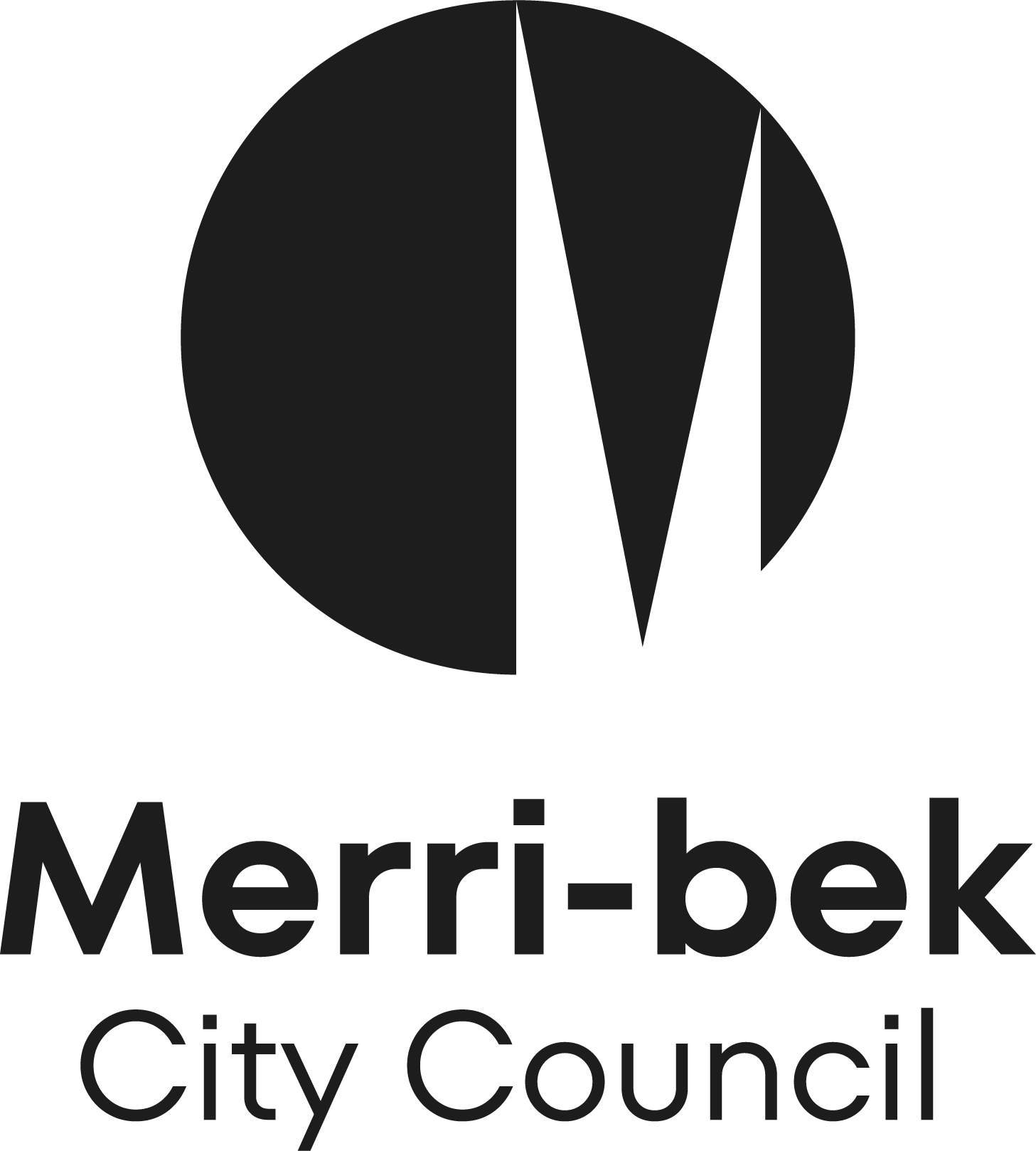 .
. 
